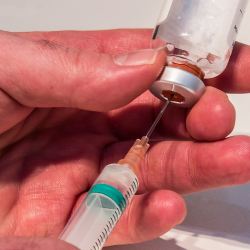When negative reviews of their then-major product appeared in the Journal of the American Society of Anesthesiologists (ASA), the manufacturer claimed trade libel and sued. And lost. The basis for the Court’s decision revolved around the constitutional right of free speech of the researchers and editor. The Court got the decision right – but for the wrong reason. Does it matter?
The case concerns the FDA-approved drug Exparel (liposomal bupivacaine), a long-acting local anesthetic used to control post-surgical pain manufactured by Pacira Biosciences, Inc. The February 2021 edition of the ASA Journal contained a clinical review of 76 studies and a meta-analysis of nine studies, concluding that the drug is “not superior to standard anesthetics.” The results were echoed in the editorial. At the time, Pacira’s stock was trading at over $75.00 a share; by October, it had tanked to $48.00 a share. As of 2020, Exparel represented nearly all of Pacira’s total revenue.
Pacira might have had reason to be miffed. The “offending” editorial read:
“Liposomal Bupivacaine: Effective, Cost-effective, or (Just) Costly?”
Pacira’s complaint reads like it was victimized. They claim the studies reached unqualified conclusions, cherry-picked adverse studies, used flawed methodologies, generally ignored studies favorable to the drug, and that two authors failed to disclose financial conflicts of interest. They also claim that the ASA offered a continuing medical education (CME) program, which contained answers based on these articles (i.e., that Exparel is “inferior” to standard anesthetic), along with publishing a podcast repeating these conclusions.
And so Pacira sued for trade libel, claiming that the conclusions were (among other reasons) biased or based on biased studies.
Free Speech and Trade Libel
Trade libel is a type of defamation – applied to products. While defamation is a remedy for harming a personal reputation, trade libel remedies harm to the reputation of one’s property or product. Both are exceptions to broad free speech protections, which recognize a special interest in protecting the free flow of “commercial information.” In reaching its decision, the Court relied on free speech Law, categorizing three components of speech and their free speech protections.
Content
“If a statement could be construed as either fact or opinion, however, we must construe it as an opinion [and] hence it is non-actionable.”
The Court noted several forms of content upon which the determination of whether the claim will lie:
- Opinion - which is always non-actionable.
- “Mixed” opinions based on undisclosed facts – generally not actionable.
- Factual – can be actionable.
- Ambivalent– non-actionable.
Because the Court categorized the authors' descriptions, i.e., “inferior analgesic” or “not superior,” as “loose” or figurative language, it concluded the language should be categorized as nonactionable rhetorical hyperbole.
In reaching its decision, the Court relied on legal opinions concerning advertising; “whether something is the ‘best’ is highly speculative and almost always a matter of opinion.” Comparing scientific discourse to commercial advertisements, the Court ruled that the scientist-readership would not be misled by the journal articles, which they obliquely compared to “false advertising.”
“If …. statements of relative superiority would not mislead an average consumer, then similar statements made in an academic journal will not mislead the experts reading the article.”
Verifiability
“Requiring that a statement be verifiable [before suit can be brought] ensures that the defendants are not punished for their First Amendment right to express their thoughts.”
Secondly, the Court discusses verifiability, which they misunderstand as whether a scientific statement is “capable of truth … or falsity,” before determining that the article’s conclusions were tentative, not verifiable, and therefore not actionable.
In reaching its decision, the Court confuses scientific verifiability and reliability while simultaneously accusing Pacira of the same mistake. In science, verifiability means testable, while reliability means repeatable - not trustworthy, as the Court believes. In science, the concept of verifiability is incongruous with a study’s reliability. In head-scratching language, the Court concludes that Pacira’s objections focus on reliability, which is irrelevant; hence, their claim is not actionable.
“Mere disputes about the reliability of a scientific study’s disclosed methodology cannot create an actionable falsehood for trade libel as such disputes do not address whether the statements themselves are verifiable.”
While noting that scientific discourse would be chilled by allowing the action to proceed, the Court opines that the statements involved are tentative scientific conclusions and hence not verifiable [1] – and relies on the studies' typical “limitations” sections to prove their uncertain nature. Moreover, since one of the studies raises issues “open to further research,” the Court concludes the articles are not verifiable or factually based. Hence, the authors are immune from suit.
“Most conclusions contained in a scientific journal article are, in principle, capable of verification or refutation by means of objective proof….At the same time, however, it is the essence of the scientific method that the conclusions of empirical research are tentative and subject to revision….”
To square the circle, the Court is forced to conclude, “because ‘scientific’ conclusions are subject to perpetual revision, they are not verifiable.” That invites their following incredible clause, “[B]ecause ‘a scientific conclusion’ ...is subject to revision – [it] is not a fact.”
Such conclusions demean the integrity of the standards of research required for publication, impugn the peer-review process, demonstrates an ignorance of the importance of such research, and force the Court to speak out of both sides of their mouth.
Are scientific conclusions facts?
Since most scientific findings are subject to revision – one must conclude that science is not factually based. Not a reassuring or socially optimal conclusion when false science, such as “vaccines don’t work,” is being spread throughout social media and paid-for journals.
“…[Context is determined by] the medium by which the statement is disseminated and the audience to which it is published.”
The decision concludes that ASA’s readers “are best positioned to identify opinions” and “chose to accept or reject them on the basis of an independent evaluation of the facts.”
Broadening the concept of context, we can look at the background which germinated ASA’s issue and editorial:
Exparel was licensed by the FDA in 2009. FDA approval is not contingent on superiority over existing drugs, merely on safety and efficacy compared to a placebo. Pacira did submit studies of ostensibly comparable drugs, showing its product as superior. Nearly half of these studies succumb to the same charge Pacira levels at the ASA article authors: it seems that they were heavily biased and/or industry supported.
The authors of the meta-analysis concluded:
“Used perineurally in peripheral nerve blocks, liposomal bupivacaine provides a clinically unimportant improvement in … postoperative pain scores compared with non-liposomal bupivacaine…. High-quality evidence does not support the use of perineural liposomal bupivacaine over non-liposomal bupivacaine for peripheral nerve blocks.”
The authors of the clinical review were both more nuanced -- and more outraged about its continued use:
“… the preponderance of current evidence fails to support the routine use of liposomal bupivacaine over standard local anesthetics when treating postoperative pain …. [B]efore widespread adoption, it is incumbent on those proposing a switch to liposomal bupivacaine to provide high-quality data …. with a low risk of bias conclusively demonstrating benefits that justify the 100-fold increase in cost over unencapsulated bupivacaine.”
These statements are hardly tentative. Moreover, they are based on testable, i.e., verifiable (and tested) studies. Yet, in defending the ASA journal publications, the Court reaches for constitutional arguments, trivializing the articles' importance and the researchers' recommendations. Physicians read such articles precisely because they don’t have the time, or in some cases, the expertise, to review the underlying data themselves. When courts trash the contents of journals published by respected medical organizations on inapt legal grounds rather than using standards for evaluating scientific evidence as adduced by the Daubert and Joiner cases, medical care may suffer.
The Court might have noted that the custom and practice in medicine is that authors are free (and often invited) to write detailed opposition viewpoints. Alternatively, Pacira could have attacked the meta-analysis, publishing their findings and stating their specific objections and claims. Finally, the Court could have said that the scientific community's consensus disagrees with Pacira; hence, it belongs in the sound and legally admissible science category.
Here’s what the ASA editor had to say:
“Why is all of this important? New drugs can be very financially rewarding for pharmaceutical companies. Once Exparel was approved, Pacira Biosciences began an aggressive and powerful marketing strategy. Between 2013 and 2019, they paid $25.8 million to more than 27,000 physicians for a variety of services, including compensation for being a speaker or faculty at nonaccredited educational events. Sales of liposomal bupivacaine increased during this time, with the company reporting a 25% growth in 2019 over 2018 with full-year revenues of $421 million in 2019. The cost of a single dose of 266 mg of Exparel brand liposomal bupivacaine is about $334. Nonliposomal bupivacaine costs about $3 per dose.”
Bias, anyone?
[1] A critical difference between science and law is that in science, all conclusions are considered tentative truths subject to revision. In contrast, the law looks at truth as a finality at a given point in time.

